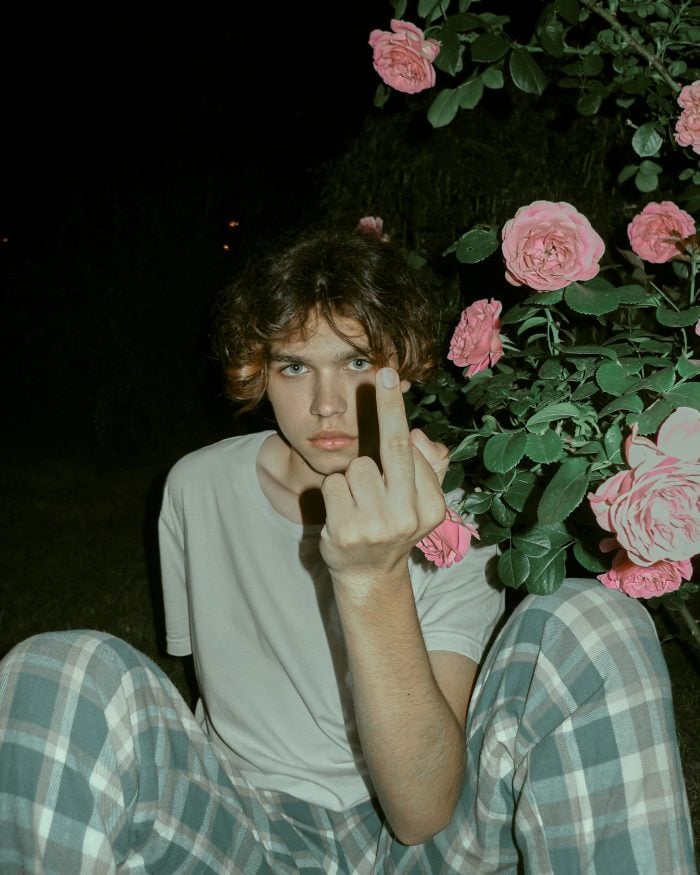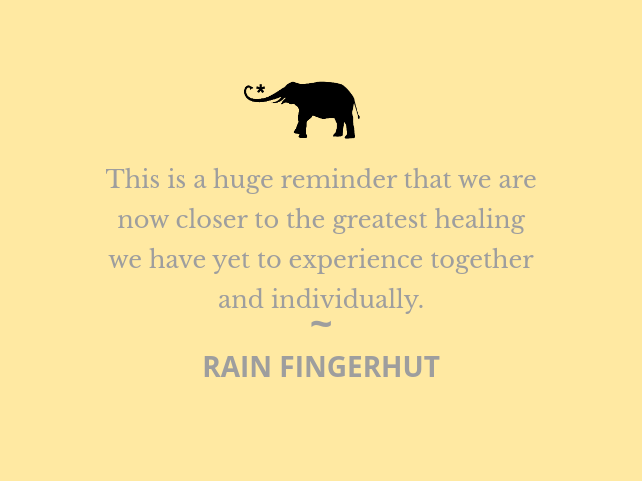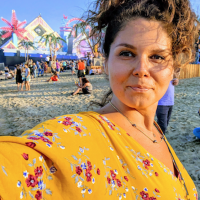Times of Covid reared its head as the “Great Opportunity.”
I don’t believe one of us came out unscathed, unchanged, unprovoked, or a little devolved.
What else can possibly happen when your seemingly light-speed life is forced upon a dense, brick wall, where you might either climb, evaporate, or liquify in order to get through the cracks?
The beauty in all things, of all times, is found in remembering of the purpose of such life-altering events.
Let’s rescue ourselves from a particularly numb “everything happens for a reason,” and be brave together to feel our fears and investigate our “I know why this had to happen.” I urge and dare you to take my hand now and let us rise to the age of our adolescent healing, which our world has plainly shown we are now ready for.
Before Covid hit, I was still very much “on the journey of healing,” up on all current psychology trends, inner child work, and the typical and well-versed antics that “all our personal issues are rooted in our families.” I’ve noticed a build-up, a huge universal tension around anxiety disorders, mental health awareness, toxic family dynamics (like narcissism), our society’s obsession with trauma and feeling your feelings, softening men’s tough exteriors, empowering women to be b*tches, and delighting the needs of our inner children. We are still there, many of us.
But when do we finally get to say, “I’m healed,” instead of “I’m healing?” When can we begin refusing the extra coddling of “always being on the journey” without ever actually transforming anything? When do we become the active authors of our own life, or more poignantly, consciously navigate the unthinkable, unimaginable, or cosmically uncomfortable that is happening around us with our sense of self intact?
Nature is not a “hot mess,” after all. Nature is a boundless, unpredictable, unreproducible force that is infused with divine timing, divine order, and divine purpose.
The trick I learned during Covid was accepting that yes, there is childhood trauma. We get hurt as children, and it doesn’t take much to do it, just as it doesn’t take much to heal it. Once we’ve healed the inner child, we have to keep going. Once we’ve graduated those sweet and precious little gems, we have to accept and get back to the simplicity and innocence they honestly represent and move on. Forgive, and step forward. We love you.
But once we get there, to continue living that trauma is a conscious choice of the living adolescent in all of us, not the inner child.
Allow me to explain:
Our adolescence was an important time in our lives, when we began breaking the mold of our upbringing and developing an awareness of mental ideas outside of our home, wherever, whatever, or whoever that home was. The comforts of childhood were stripped away from our awareness at some point in our adolescence in such a way that it rocked us to our core. And the only way to protect ourselves from the intensity of the fear, anxiety, and feelings of isolation and separation, was to start distinguishing things in black and white, absolutes and hard-and-fast, rigid ideologies, choices, and “truths” that got us through this time of intense spiritual reckoning. Whether we knew it or not, at that moment, we wrapped our arms around a jagged rock formation of stability in the middle of a storm-fueled ocean and held on for our lives forever more.
Let’s call this the time of the “Great Adolescent Rip.”
This was a time in our adolescence where something remarkable happened—perhaps a family divorce, the loss of our first great love, the death of a loved one, a move, a life-altering betrayal. It was something so personal, so very subconscious to us, a true meaning of comfort and belonging was ripped from us in such a deep way that it could very well have rocked our entire understanding of our identity, mental health, well-being, and beliefs for years to come.
When you think about this time in your life, something may come to mind instantly, or it could require some digging because of how deeply it’s buried due to the intensity. However, to be quite honest, it would be cruel of me to ask you to unearth it right at this moment.
Yes, this happened to every single one of us.
It is the universe’s way of pushing humans off a cliff for the profound purpose of growing up.
When something so earth-shattering happens at a time when our mental state is beginning to actively identify with the outside world, the only thing we can think to do is stabilize by any means necessary, and no matter how hard the tempest is blowing.
So, how do we start to do that as an adolescent? To make it simple, we start to feel instead of think, or think instead of feel.
Hence the rigidity, the black and white, hard-and-fast rules that give us a sense of stability against the relentless uncertainty of a treacherous new landscape, that only yesterday represented comfort and belonging, and that has now been ripped away.
“Leave me alone! You don’t understand me!”
“How could you do this to me?”
“You’re so stupid! I’m right and you’re wrong!”
These are hollow, ghostly cries for control against a new world that we now feel like burning to the ground because all of a sudden, there is not one person on the entire planet who could possibly understand how alone we truly feel.
The great adolescent rip—hormones? Sure. But it is so much more.
These choices and feelings are no longer those of your hurt, healing inner child. These choices are much too complex, intricate, and sophisticated. It’s your adolescent who is actively in the role of offender now, using only the echoes of an unhealed childhood as additional ammunition, if needed, in its rigidity and justification for half-blind, half-optimized, and half-whole decision making.
Sometimes, in our rigidity, we cling to the past of immaturity instead of embracing our adulthood. Sometimes, we say we will never love again to protect ourselves. Sometimes, in our grip for control, we decide we will only focus on money and our ambitions for the rest of our lives. Sometimes, we surrender our chance at true intimacy and vulnerability for manipulation. Some choose to forever be the hero or savior at the expense of their personal truth. Some follow only their head, or only their heart. Sometimes, we continue on in a string of codependent relationships, even if they are all destructive and toxic. Some then become obsessed with a standard of perfection that does not exist, while others will abandon all hopes of self-care, health, and well-being. Some will choose to externalize the tempest, living a life of projecting their inner world onto everything and everyone outside of themselves, furthering the feelings of separation. Some of us refuse to create a life that we feel happy in, and never allow ourselves to experience the risk of success. Some never choose to have a good relationship with their parents, ever again, or refuse to heal even at 30, 40, or 50 years old, to never let the villains of their pasts “off the hook,” because someone needs to pay for the wounds their life has endured.
And worse, some of us begin hurting other people, in a string of half-conscious, boldly destructive blows: our partners, our friends, our children.
All these choices are for the sole purpose of alleviating or coping with the one thing our society has the most difficult time honestly looking at, allowing, and healing: our pain.
I’d like to add a disclaimer here. None of the actions that I have listed above are weighed in a scheme of right or wrong. The complexity of knowing how, or even if the adolescent is in your driver’s seat currently, is one of the most complex and enduring journeys you’ll experience in healing. It requires a personal and unique measure of feeling when it’s right, and thinking when it’s right, and it has nothing to do with our actions themselves, but the why behind them.
But I’ll give you a hint: if there are perpetual habits in your life, or major self-propelled crises, and your answer to “why” you are doing them is an instinctive “I don’t know,” you’re dealing with the adolescent. Additionally, the answers to healing the adolescent are far more intricate and beautiful than doing the opposite of what you’re currently doing to fix it. Exciting, isn’t it?
Well, what is there to do now?
Earlier, I gave a relatively simple answer of feeling vs. thinking, but that was to just get the adolescent in you to keep reading. The adolescent loves a good cheat sheet, which brings much less anxiety, angst, and fear in its desperation to get to the elusive finish line and feel relief from the stress, the shame, the anxiety, the depression, and so much more. But there’s a secret: there is no finish line.
The truth is, complex solutions must rise to the occasion of complex problems. Luckily, the route to healing is a sheer celebration of self-awareness and self-authoring, and the reckless abandonment of the destructive arrogance, anger, anxiety, and hubris of adolescence. What a relief.
To heal the adolescent, one must get ready for the ultimate relationship of their lives—with reality.
This article is not about how to heal the adolescent, but it is a nod to the fact that we are now ready to heal it. This is a huge reminder that we are now closer to the greatest healing we have yet to experience—together and individually. So many ways will present themselves for that opening and that moment. Hoorah!
Only a willfully healing adolescent will understand the possibilities of that freedom. And it is our Spiritual Adult selves who will truly feel it, fluidly playing along the bounty of their open timelines, past, present and future—but that is for another time and conversation.
Just as quantum physics is showing us a bridge between science and spirituality, so is our inner adolescent awakening as the bridge between the unhealed self and the boundless, and we begin to remember who we really are.
You are the artist. You are the conductor. You are healed. And you are whole. And your only measure for limitations, is in the divine.












Read 8 comments and reply